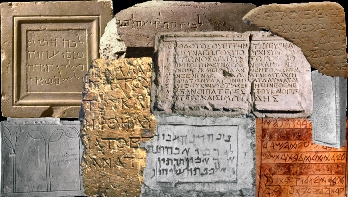| | 01 March, 2011
| | Major research project documents for first time all ancient inscriptions from Jerusalem and surrounding area | |
 | | The first volume of the collection includes more than 700 inscriptions from Jerusalem and surrounding areas up until the destruction of the Second Temple. |
|
The first installment of a major international research project gathering all the inscriptions ever found in Israel and the Palestinian Authority from the period of Alexander the Great (4th century C.E) until Mohammed (beginning of the 7th century A.D.) has recently appeared. The Corpus Inscriptionum Iudaeae/Palestine (CIIP), as the collection is called, will eventually encompass nine volumes, and promises to become one of the most important tools of research into this period. The first volume of the collection includes more than 700 inscriptions from Jerusalem and surrounding areas up until the destruction of the Second Temple.
The project began in 1999 and includes researchers at the Hebrew University of Jerusalem, (Hannah Cotton, Leah di Segni, Haggai Misgav and Ada Yardeni), Tel Aviv University (Benjamin Isaac, Alla Kushnir-Stein, Jonathan Price and the late Israel Roll) and the University of Cologne (Werner Eck and Walter Amling). Future volumes will bring in researchers from Oxford University as well.
''This is the only collection of inscriptions from the Roman-Hellenistic world that is multilingual and documents together inscriptions in all of the languages used locally,'' explains Prof. Hannah Cotton of the Department of Classics at the Hebrew University, who is one of the editors of this project. ''Along with the languages of the superpowers of the time - Greek and the Latin - were also Hebrew, Phoenician and the various Aramaic dialects (Jewish Aramaic, Samaritan, Nabataean, Syriac, Christian Palestinian Aramaic), Middle Persian, as well as Thamudic and Safaitic, and finally Armenian and Georgian – representing the diversity of cultures that existed in the Land of Israel in the same era.''
This ambitious project is not a mere catalogue of previous finds. Every known inscription was reexamined and its interpretation considered afresh. In their search for the inscriptions, the researchers – historians, philologists and archaeologists – scoured a wide range of sites in Israel and around the world. They combed through the many collections of the Israel Antiquities Authority, but also churches and monasteries, museums, archaeological sites and even literary texts in which evidence of inscriptions has been preserved (such as the inscription on the cross recorded in the New Testament). Each inscription, accompanied by a picture or sketch, was translated into English, along with its commentary and bibliography. A number of the inscriptions that appear in the first volume were never published before, and such will be the case in subsequent volumes as well.
According to Prof. Cotton, ''The pluralism and inclusiveness of this new work isn’t merely a fashionable expression or response to the modern demand for equal recognition of social and cultural diversity. Although such modern sensibilities were bound to transform our perception of Graeco-Roman antiquity, in our case there is a more central motivation. We seek to present the historic truth of local linguistic diversity as attested by the many surviving written documents. Our approach is in fact the only means possible to evaluate correctly the wealth of the collective epigraphic tradition as historic truth. We have done away with outdated scholarly divisions which presented inscriptions in separate linguistic compartments as though every language inhabited an isolated world, and depict the epigraphic evidence as it exists, as an authentic expression of varied and different cultures and societies that existed together, in the Middle East in general, and the land of Israel in particular. Specifically here, the cultures and languages that preceded the Greco-Roman period demonstrated their resilience and their capacity for survival in the face of the “globalizing” trends of the time. They remained more vital and vibrant than elsewhere in the Graeco-Roman world.”
The Jerusalem volume reflects this approach. The range of inscriptions in the collection is large, and they shed light on daily life in Judaea and Jerusalem, such as colored labels in ink on jars, receipts written on pottery shards, but above all the names of individuals and family members written on ossuaries which contain the bones of the deceased. From time to time we find inscriptions immortalizing events, people and places mentioned in the ancient sources, like the one of Nikanor “who made the gates”, recorded in rabbinic sources, the prohibition in Greek from the Temple compound forbidding foreigners to enter the inner courts and the sanctuary, and a Hebrew inscription (''To the Place of Trumpeting”), which was originally located in the southwestern corner of the Temple Mount and marked in all probability the place where a trumpet was blown to mark the beginning and end of the Shabbat.
The second part of the Jerusalem volume and the volume on Caesarea and its environs will be published later this year. The corpus has been supported since 2005 by the DFG German Research Foundation and the Ring Fund of the president of the Hebrew University, and in the past by ISF - the Israel Research Foundation and GIF- the German-Israel Research Fund.
|
Downloadable File: CottonInscriptions.doc |
|


